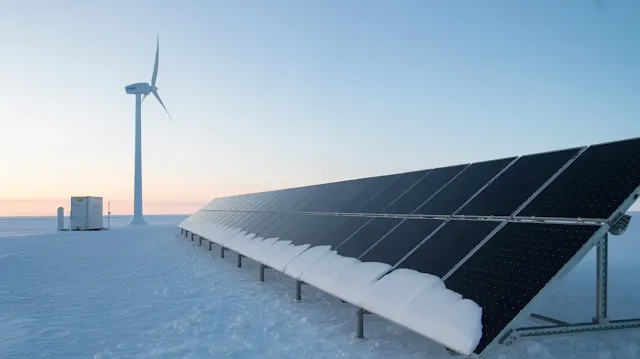Renewable Energy in Polar Environments: Smart Solutions for Extreme Conditions
Clean Energy Reaches the Coldest Corners of Earth
As global warming drives the need for sustainable energy everywhere, the polar regions have become unexpected frontiers for innovation. Areas like the Arctic and Antarctica, long reliant on diesel generators, are now testing clean technologies such as snow-resistant solar panels, hybrid microgrids, and cold-climate wind turbines.
The Polar Energy Challenge: Unique Obstacles in Harsh Climates
Operating energy systems in polar regions isn’t as simple as replicating standard renewable projects. Developers must deal with:
Extreme low temperatures that reduce battery and equipment performanceProlonged darkness during polar winters
Heavy snow and ice accumulation on infrastructure
Logistical challenges for transporting parts and maintaining systems
Despite these hurdles, new technologies are proving it's possible, and even efficient, to generate renewable energy in polar environments.
Solar Power in the Snow: Turning Light and Ice into Energy
Utilizing the Midnight Sun and Reflective Snow
In Arctic summers, sunlight can last up to twenty-four hours a day. By combining this with the high albedo (reflectivity) of snow-covered ground, solar panels can generate surprisingly high outputs. Modern bifacial panels, which capture sunlight from both sides, make the most of reflected light.
Innovations in Solar Panel Design for Cold Weather
To prevent energy loss and damage, engineers are now creating solar panels that:
Are mounted vertically to reduce snow buildupUse anti-icing coatings to maintain performance
Rely on heated systems or snow-shedding angles to stay clear
These innovations enable communities in Canada, Norway, and Greenland to install cost-effective solar solutions.
Wind Energy in Arctic Winds: High Yields with Resilient Turbines
Harnessing Consistent and Powerful Wind Currents
Wind is plentiful and reliable in many polar regions. Specially engineered low-temperature wind turbines with sealed gearboxes and antifreeze components can now handle extreme conditions without failing.
Case Study: Antarctic Research Stations
Projects in Antarctica are using wind turbines to reduce reliance on diesel. By combining wind and solar, stations maintain power supply year-round, even during long dark winters.
Hybrid Systems and Microgrids: Building Reliable Arctic Infrastructure
Combining Solar, Wind, and Battery Storage
Hybrid systems offer a balanced approach. In places like Svalbard and northern Alaska, microgrids now incorporate:
Solar energy for summer generationWind turbines for windy winters
Lithium-ion battery storage to balance supply and demand
Diesel backup, gradually being phased out
These systems bring resilience and autonomy to remote villages, reducing carbon footprints and fuel costs.
Smart Materials and Nanotech in Cold Energy Systems
Advanced Coatings and Materials for Polar Panels
New technologies like graphene layers and nano-insulated materials are making solar cells more efficient at lower temperatures. Panels can now retain heat longer, preventing frost buildup and maintaining conductivity.
Wind Turbines with Ice-Sensing Blades
Engineers have developed intelligent turbine blades that sense ice accumulation and adjust blade angles or activate heating systems to stay operational in snowstorms.
Environmental and Economic Benefits for Polar Communities
Drastic Reduction in Diesel Consumption
Renewable installations are helping remote communities cut diesel use by up to ninety percent, reducing air pollution, shipping costs, and dependency on fossil fuels.
Job Creation and Energy Independence
Installing and maintaining renewable systems boosts local economies, particularly in indigenous and underserved Arctic communities. They gain both technical skills and energy autonomy.
Policy Support and International Cooperation
Government Investment in Clean Arctic Development
Countries like Canada, Norway, and Finland have introduced grants and subsidies for clean energy in remote regions. These policies support infrastructure deployment, R&D, and energy equity.
Arctic Council and Global Energy Collaboration
Multinational cooperation through entities like the Arctic Council helps standardize safety protocols, share data, and foster innovation across borders.
The Future Outlook: A Renewable Polar Revolution
Integration of Green Hydrogen and Smart Grids
Future systems aim to integrate green hydrogen production using surplus renewable power. Hydrogen can be stored and used as fuel in winter months when solar output is minimal.
From Remote Experiments to Global Blueprints
What starts in the Arctic could soon apply to other extreme environments, such as high-altitude locations or disaster zones. Polar energy solutions may become blueprints for sustainable development in the harshest corners of the globe.
Conclusion: Clean Energy Triumphs Even in the Coldest Climates
The idea of generating renewable energy in polar regions is no longer a dream, it’s an emerging reality. Through cutting-edge solar designs, advanced wind technologies, and hybrid energy systems, communities in the coldest parts of the planet are lighting their homes and powering their lives with clean, sustainable power.
As innovation continues, the poles might just lead the world’s clean energy transition, proving that even in total darkness or subzero temperatures, a brighter future is possible.




Write a comment, your opinion matters to us